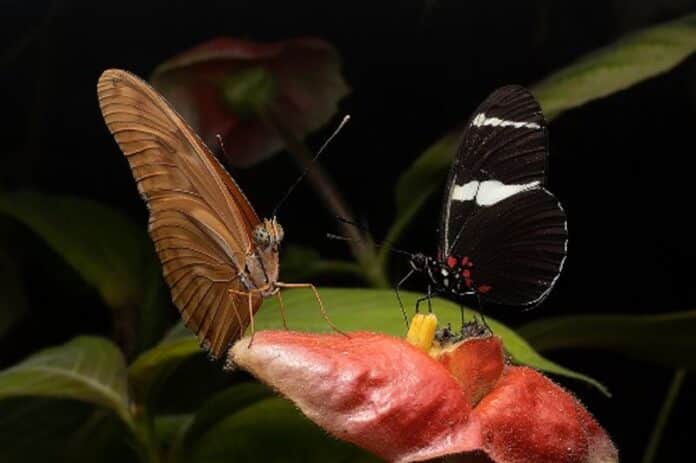Animal behavior, senses, and cognitive capacities result from evolutionary advances and brain system modifications. The nervous system has evolved to allow animals to sense and interact with their surroundings. Brain evolution models emphasize the coordinated evolution of functionally connected networks, with localized specialization focusing on refining existing functions.
They have a two to four-times larger mushroom-shaped brain area known as the mushroom body than their close cousins do. According to a new study, an organism’s behavior and ecological niche are directly related to the anatomy and operation of its neural system.
Dr. Stephen Montgomery of Bristol’s School of Biological Sciences explained, “Heliconius are the only butterflies known to collect and digest pollen, which gives them an adult source of protein when most other butterflies exclusively obtain protein as caterpillars.”
Heliconius butterflies are the only ones known to gather and digest pollen and the only ones to have extended lifespans. However, they can only collect pollen from a few low-density plant species. They must make more significant investments in the brain networks and cells that assist spatial memory since learning the locations of these plants is a crucial behavior for them.
The research team concentrated on the interaction between sensory specialization, body enlargement, and the evolutionary adaptation of pollen feeding. They constructed 3D models of the brains of 30 Heliconius species that feed on pollen and 11 species from closely related genera gathered from Central and South America.
It was possible to determine where significant evolutionary changes in brain composition happened by measuring the volume of various brain regions and mapping them onto phylogenetic trees.
They then examined sensory specialization by tracing neural inputs from brain regions that process visual information and smell before sending it to the central brain, quantifying the number of neurons in the mushroom bodies and the density of their connections.
They conducted behavioral studies on important species in collaboration with the Smithsonian Tropical Research Institute in Panama to see whether the mushroom body’s observed growth was associated with enhanced visual learning and memory.
One notable outcome is the amazing range of mushroom body size variation discovered among these closely related species within a brief evolutionary interval. The size of the mushroom varies by 25 times across the entire dataset.
This provides an illuminating illustration of how distinct brain areas can evolve independently over evolutionary time, a process known as mosaic evolution when subjected to stringent selective pressures for behavioral adaptation.
He added: “We identified that changes in mushroom body size are due to an increased number of ‘Kenyon cells, the neurons that form the majority of the mushroom body and whose interactions are thought to be the basis of memory storage, as well as increased inputs from the visual system.”
The researcher from the University of Bristol said, “This expansion and visual specialization of the mushroom bodies were accompanied by enhanced visual learning and memory abilities. Through this synthesis of data types, we provide a clear example of a novel foraging behavior coinciding with adaptations in the brain and associated cognitive shifts.”
The new study demonstrates how the Heliconius butterfly’s brain structure, particularly the mushroom bodies, has experienced notable alterations closely related to their specialized foraging activities. These butterflies have larger mushroom bodies and improved visual processing skills, enabling them to distinguish between complicated visual patterns and maintain long-term memory. These studies show the interesting relationship between brain evolution and behavioral adaptations in the natural world.
Dr. Fletcher Young, also co-lead author, added: “This study provides a rare combination of neurobiological and behavioral data across closely related species, revealing a clear example of marked evolutionary changes in the brain over a relatively short time scale coinciding with improved visual learning and memory abilities. Identifying such relationships between brain adaptations and behavioral shifts are crucial to our understanding of cognitive evolution.”
As the function and circuitry of mushroom bodies share some similarities with vertebrate brains, understanding the relationship between brain anatomy, sensory processing, and foraging behavior in Heliconius butterflies may shed light on how learning and memory mechanisms have evolved in insects and other animals.
Dr. Montgomery concluded, “We provide evidence that brain structure can vary strikingly between closely related species living in the same habitats.
Journal Reference:
- Couto, A., Young, F. J., Atzeni, D., et al. Rapid expansion and visual specialization of learning and memory centers in the brains of Heliconiini butterflies. Nature Communications. DOI: 10.1038/s41467-023-39618-8
